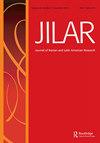《巴拉圭森林里的幽灵:雨果·吉米内斯的《死亡之歌》中的秘密语法(2019)
IF 0.3
0 HUMANITIES, MULTIDISCIPLINARY
Journal of Iberian and Latin American Research
Pub Date : 2023-01-02
DOI:10.1080/13260219.2023.2218072
引用次数: 0
摘要
本文考察了雨果·吉米内斯的小说《死亡的坟墓》(2019),故事发生在1978年的巴拉圭和阿根廷独裁统治时期。我把这部电影置于后独裁时代的电影语境中。我的细读偏离了记忆研究,通常是对南锥体后独裁文化产物的研究。相反,我深入研究了这部电影是如何融入政治惊悚片的,这种类型起源于北美,在拉丁美洲越来越流行。我介绍了一种我称之为秘密语法的体裁,一种通过空间介词描绘秘密的方式。我关注这部惊悚片如何将巴拉圭森林中的语言、政治、幽灵和秘密空间化,以描绘国家支持的强迫失踪。根据陶西格的“公共秘密”,我将我所谓的“危险秘密”理论化,这是拉丁美洲政治惊悚片的特色,展示了该类型中具有共同元素的其他作品。最后,我考虑了秘密和幽灵的表现的政治含义。本文章由计算机程序翻译,如有差异,请以英文原文为准。
Specters in the Paraguayan Woods: The Grammar of Secrecy in Hugo Giménez’s Matar a un muerto (2019)
ABSTRACT This article examines Hugo Giménez’s Matar a un muerto (2019), set in 1978 during the Paraguayan and Argentine dictatorships. I contextualize the film in post-dictatorial cinema. My close reading strays from memory studies, often privileged in studies of Southern Cone post-dictatorial cultural productions. Instead, I delve into how the film engages with the political thriller, a genre originated in North America becoming more and more practiced in Latin America. I introduce what I call the genre’s grammar of secrecy, a way of picturing secrets through prepositions of space. I focus on how this thriller spatializes languages and politics, specters, and secrets in the Paraguayan woods, to portray state-sponsored forced disappearance. Following Taussig’s “public secrets,” I theorize what I call precarious secrets, distinctive to Latin American political thrillers, showcasing other works in the genre with shared elements. Finally, I consider political implications of the representation of secrecy and specters.
求助全文
通过发布文献求助,成功后即可免费获取论文全文。
去求助
来源期刊

Journal of Iberian and Latin American Research
HUMANITIES, MULTIDISCIPLINARY-
CiteScore
0.60
自引率
0.00%
发文量
22
 求助内容:
求助内容: 应助结果提醒方式:
应助结果提醒方式:


